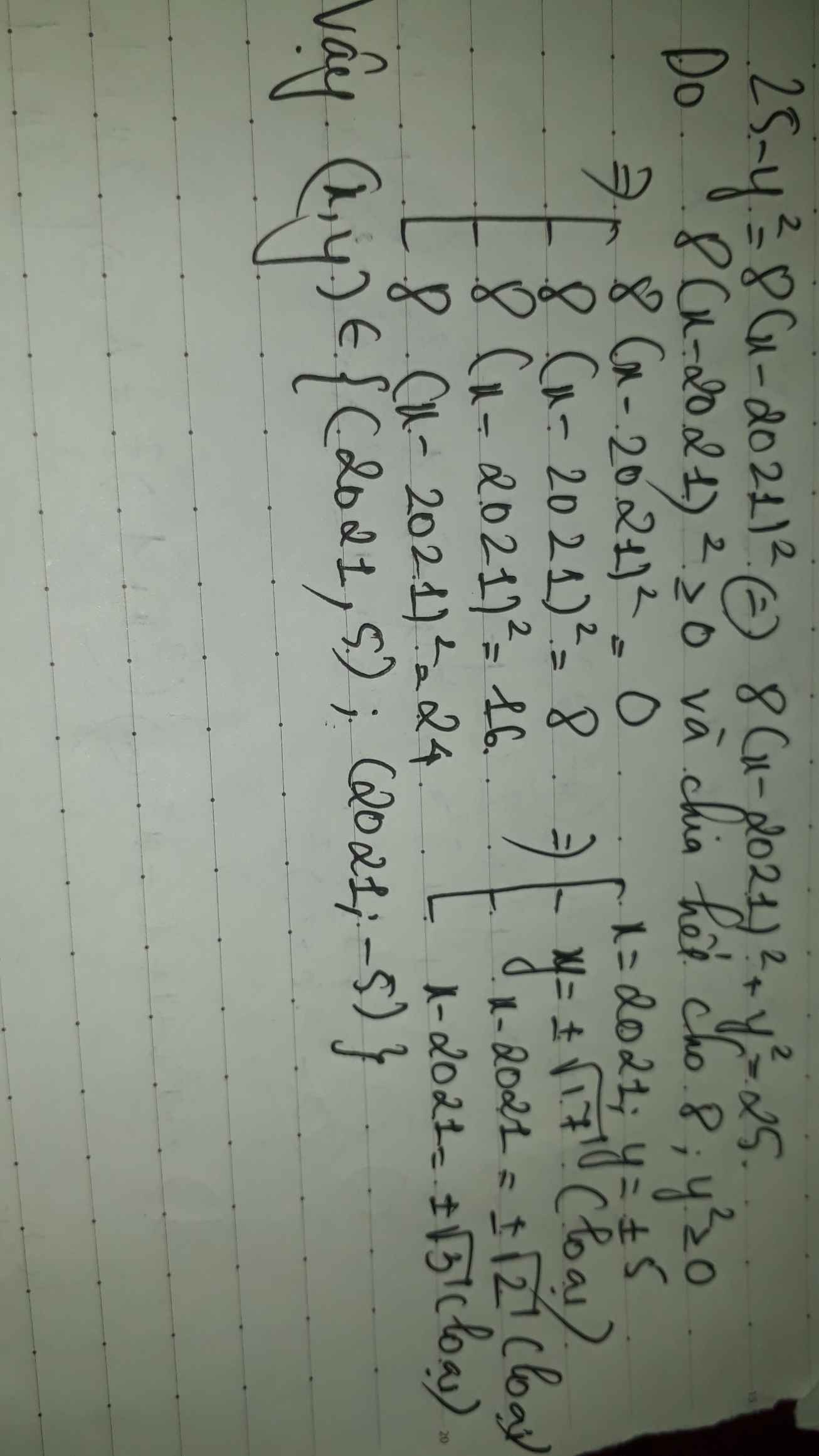
Hãy nhập câu hỏi của bạn vào đây, nếu là tài khoản VIP, bạn sẽ được ưu tiên trả lời.


\(8\left|x-2017\right|=25-y^{2\text{}}\)
\(\Leftrightarrow8\left|x-2017\right|+y^2=25=25+0=24+1=21+4=16+9\)
Mà \(8\left|x-2017\right|\) chẵn nên ta có các trường hợp sau:
TH1: \(\left\{{}\begin{matrix}8\left|x-2017\right|=0\\y^2=25\end{matrix}\right.\Leftrightarrow\left\{{}\begin{matrix}x=2017\\y=\pm5\end{matrix}\right.\)
TH2: \(\left\{{}\begin{matrix}8\left|x-2017\right|=24\\y^2=1\end{matrix}\right.\Leftrightarrow\left\{{}\begin{matrix}\left[{}\begin{matrix}x=2020\\x=2014\end{matrix}\right.\\y=\pm5\end{matrix}\right.\)
TH3: \(\left\{{}\begin{matrix}8\left|x-2017\right|=16\\y^2=9\end{matrix}\right.\Leftrightarrow\left\{{}\begin{matrix}\left[{}\begin{matrix}x=2019\\x=2015\end{matrix}\right.\\y=\pm3\end{matrix}\right.\)


đk đã cho \(\Leftrightarrow\)\(8\left(x-2022\right)^2+y^2=25\) (1)
Vì \(\left(x-2022\right)^2\ge0;y^2\ge0\) nên (1) suy ra:
\(8\left(x-2022\right)^2\le25\)
\(\Leftrightarrow\left(x-2022\right)^2\le\dfrac{25}{8}\)
Do \(x\inℤ\) nên suy ra \(\left(x-2022\right)^2\le3\)
\(\Rightarrow x-2022\in\left\{0;\pm1;\pm2;\pm3\right\}\)
\(\Rightarrow x\in\left\{2022;2023;2021;2024;2020;2025;2019\right\}\)
Nếu \(x=2022\Rightarrow y=\pm5\)
Nếu \(x\in\left\{2021;2023\right\}\) thì \(y^2=17\), vô lý.
Nếu \(\left|x-2022\right|\ge2\) thì \(8\left(x-2022\right)^2\ge32\) \(\Leftrightarrow25-y^2\ge32\) \(\Leftrightarrow y^2\le-7\), vô lý.
Vậy có các cặp số (x; y) sau thỏa mãn:
\(\left(2022;5\right),\left(2022;-5\right)\)
Do (x - 2022)² ≥ 0 với mọi x R
8(x - 2022)² ≥ 0 với mọi x R
25 - y² ≥ 0
y² ≤ 25
⇒ y ∈ {-5; -4; -3; -2; -1; 0; 1; 2; 3; 4; 5}
Do x, y ∈ Z nên (25 - y²) ⋮ 8
⇒ y ∈ {-5; -3; -1; 1; 3; 5}
⇒ (25 - y²) : 8 ∈ {0; 2; 3}
⇒ (x - 2022)² ∈ {0; 2; 3}
⇒ x - 2022 = 0
⇒ x = 2022
Vậy ta tìm được 2 cặp giá trị (x; y) thỏa mãn:
(2022; -5); (2022; 5)


sua lai bai cua minh
Neu \(\left(x-2017\right)^2=1\\ =>x-2017=1\\ =>x=2018\)
Vay \(25=8\left(x-2017\right)^2+y^2\\ =>25=8+y^2\\ =>y^2=17\left(loai\right)\)(do x;y \(\in N\))
Vay \(x=2017;y=5\)
Ta co
\(25-y^2=8\left(x-2017\right)^2\\ =>25=8\left(x-2017\right)^2+y^2\)
Do
\(8\left(x-2017\right)^2\le25\\ =>\left(x-2017\right)^2\le\frac{25}{8}\)
\(=>\left(x-2017\right)^2\in\left\{0;1\right\}\)
Neu
\(\left(x-2017\right)^2=0\\ x-2017=0\\ x=2017\)
Vay:
\(25=8\left(x-2017\right)^2+y^2\\ =>25=y^2\\ =>y=5\)
Neu
\(\left(x-2017\right)^2=1\\ =>x-2017=1\\ =>x=2018\)
Vay:
\(25=8\left(x-2017\right)^2+y^2\\ =>25=1+y^2\\ =>y^2=24\)(loai do x;y \(\in N\))
Vay x=2017 ; y=5

Cách nhanh nhất để giải bài này là dùng phương pháp chặn em nhé.
Phương pháp chặn là giới hạn các giá trị của biến kết hợp điều kiện đề bài để tìm biến. Em tham khảo cách này của cô xem.
25 - y2 = 8( \(x\) - 2015)2
ta có: ( \(x-2015\))2 ≥ 0 ∀ \(x\) (1)
Mặt khác ta có: y2 ≥ 0 ∀ y ⇒ - y2 ≤ 0 ∀ y ⇒ 25 - y2 ≤ 25 ∀ y
⇒ 25 - y2 = 8(\(x-2015\))2 ≤ 25 ∀ \(x,y\)
⇒ (\(x-2015\))2 ≤ \(\dfrac{25}{8}\) = 3,125 ∀ \(x\) (2)
Kết hợp (1) và (2) ta có: 0 ≤ (\(x-2015\))2 ≤ 3,125
vì \(x\in\) Z nên ⇒ (\(x-2015\))2 \(\in\) Z
⇒ (\(x-2015\))2 \(\in\) {0; 1; 2; 3}
th1:(\(x-2015\) )2= 0 ⇒ \(x\) = 2015; ⇒ 25 - y2 = 0⇒ y = +-5
th2:(\(x-2015\))2 = 1⇒ 25 - y2 = 8 ⇒ y2 = 25 - 8 ⇒ y = +- \(\sqrt{17}\) ( loại)
th3: (\(x-2015\))2 = 2 ⇒ \(\left[{}\begin{matrix}x=\sqrt{2}+2015\left(ktm\right)\\x=-\sqrt{2}+2015\left(ktm\right)\end{matrix}\right.\)
th4: (\(x-2015\))2 = 3 ⇒ \(\left[{}\begin{matrix}x=\sqrt{3}+2015\left(ktm\right)\\x=-\sqrt{3}+2015\left(ktm\right)\end{matrix}\right.\)
Vậy (\(x,y\)) = ( 2015; -5); ( 2015; 5) là giá trị thỏa mãn đề bài
